Bassano B., Durio P., Gallo Orsi U., Macchi E
eds., 1992. Proceedings of the 1st Int. Symp. on
Alpine Marmot and genera Marmota. Torino.
Edition électronique, Ramousse R., International Marmot Network, Lyon 2002
HUMAN IMPACT ON MARMOT BEHAVIOUR
Neuhaus P., Mainini B., Ingold P.
Zoologisches Institut - Universität Bern, 3032 Hinterkappelen, Switzerland
Abstract - To summarize we can say that because of the hikers, marmots in highly frequented areas spend much less time outside their burrows and consequently less time foraging than animals in more remote areas. Hikers affect the marmots in the utilisation of their territory. In highly frequented territories the marmots adapt to shorter flight distances and less time in the burrows after being disturbed. Further we can say that different forms of hiking have a different influence on the behaviour of marmots.
INTRODUCTION
The Alps as a sensitive biosphere loses more and more of its wilderness area to the increasing tourism. The disturbing influence of winter activities on animals has been shown to exist (Jenny, 1984; Stucky, 1983). Our study on marmots is part of a larger project called "Tourismus und Wild" which deals with the influence of various forms of summer tourism on the behaviour of alpine mammals and birds. The object of our study on marmots was to establish how much their behaviour is influenced by various forms of hiking. This presentation deals with the following questions:
- How strong is the influence of hikers on the daily activities of the marmots?
- How does the presence of hikers affect the animals in the utilisation of their territory?
- To what extend do marmots adapt to the hiking tourism?
-How do marmots react to hikers crossing their territory at random in comparison to those who keep on the frequented trails?
STUDY AREA AND METHODS
Our study took place in the area First in the Bernese Oberland (Switzerland) in the summers 1988/89. The area can be reached with a chairlift from the tourist resort Grindelwald. There is also a restaurant and two well developed hiking paths leading through marmot habitat. On a nice summer day it is not uncommon that far more than 1000 tourists populate the area.
We defined territories to be highly frequented when they are adjacent to, or are crossed by one of the two main hiking paths. Where this is not the case the area was defined to be less frequented. To study the daily activities, three highly and three less frequented territories, where we had previously ascertained the number of individuals, were chosen. We observed the marmots from the first appearance in the morning till the last animal disappeared in the evening. Each group was observed during five whole days employing the scan-sampling-method (Altmann, 1974) using five minute intervals (Holmes, 1984).
T o establish the utilisation of the territories, the path was paced off at various times of the day and it was recorded how far from the path the animals were. Once in the morning between 7.30 a.m. and 9.00 a.m. before hikers arrived, once at noon between 11.45 a.m. and 1.15 p.m. when the greatest number of hikers were in the area and once in the evening between 5.45 p.m. and 7.15 p.m. when the tourists had left again. Each period was recorded three times. To find an answer to the question of adaptation we carried out experiments in each type of group. We walked towards the animals to establish the flight distance. Then we went to the burrows into which the animals had disappeared and left the territory to measure the time until at least one animal reappeared above ground. Again experimentally, we established the influence of hikers on the paths compared with those off the beaten trails. First we walked the paths ourselves and recorded the relevant information such as flight distance and number of animals seeking refuge in the burrows. Then we walked through the territory at random keeping the same distance to the burrows as in the previous experiment and recorded the same data. The influence of hikers on the daily activities of the marmots.
Fig. 1 shows how often the animals were observed to be outside their burrows during an average day. In less frequented areas we always observed 70 % - 90 % of the animals outside their burrows between 8.00 a.m. and 7.00 p.m. In highly frequented areas we observed as many marmots in the morning and the evening; but during the day the number above ground was dramatically reduced to a minimum of around 10 % at midday. The daily average of animals above ground in highly frequented areas was 48 %, in less frequented areas it was 71 % (Chi-Square-Test: p<0.001).
Fig. 2 shows the proportion of foraging time to total above ground activity.
In less frequented areas there were always more than 40 % of the marmots feeding.
In highly frequented areas the few animals above ground at noon showed much less foraging behaviour than those in less frequented areas. This shows clearly that marmots in highly frequented areas spend much less time foraging than animals in less frequented areas.
How does the presence of hikers affect the marmots in the utilisation of their territory?
Fig. 3 shows that at noon, all animals still above ground were more than 40 m from the paths. Most animals even more than 100m.
In the morning, before the first hikers arrived and in the evening after the tourist had left the area most animals were seen in the vicinity of the paths.
The distribution of the animals within their territories is obviously strongly influenced by the hikers.
To what extend do marmots adapt to hiking tourism? The flight distance in highly frequented areas was, with a median of 50.5 m, significantly lower than in less frequented areas where we established a median of 140 m (Fig. 4). In the highly frequented areas the first animals always reappeared within fifteen minutes after the observer had left the burrow, - mostly already after five minutes (Fig. 5 : Chi-Square-Test: p<0.01). In five experiments in the less frequented areas, no animals had reemerged when the experiments were broken off after thirty minutes. Based on these results we conclude that marmots in highly frequented areas are, to some extend, adapted to tourism.
The reaction of marmots to hikers crossing their territory at random and those who keep to the frequented paths. When we stayed on the paths the average flight distance was 31 m (n=20). When we went crosscountry through the territory the average flight distance was 51 m (Fig. 6). A significantly greater number of animals sought refuge in their burrows when confronted with hikers off the path than when confronted with hikers who kept to the trail (Tab. 1). We conclude that marmots react different by different forms of hiking tourism because of the potential danger they see in the appearing hikers.
DISCUSSION
Our data shows that hiking tourism has a strongly disturbing influence on the behaviour of marmots. Especially impressing is the fact that the animals in highly frequented territories have much less time for foraging than those in less frequented areas. The ability of the marmots to adapt exits to a certain degree. However, the results on the daily activities show that distinctly more adaptation would be necessary before the animals can utilise their time for foraging to the same degree as those in less frequented areas. Compensation by speeding foraging is not possible because food intake is limited by the amount of food which can pass through the digestive system of the animals (Bobek, 1977; Kilgore, Armitage, 1978). A negative influence on the fitness of the animals in the highly frequented areas has to be expected. A longterm study on population dynamics on the First might give an answer to this question.
We interpret the different habitat use of marmots in highly frequented areas as a restriction in the procurement of food rather than as an adaptation.
That marmots react less to hikers on the path than to those who cross their territory at random indicates an adaptation. As long as the people stay on the trail the direction of their progress is predictable to the marmots. This is, of course, not the case when hikers cross the territories at random.
Â
IMPATTO UMANO SUL COMPORTAMENTO DELLA MARMOTTA
Neuhaus P., Mainini B., Ingold P.
Zoologisches Institut - Universität Bern, 3032 Hinterkappelen, Switzerland
Â
Introduzione
Le Alpi, come parte di biosfera sensibile, perdono sempre più la loro wilderness a causa dell'aumento del turismo. L'influenza del disturbo attività invernali sugli animali é stata dimostrata (Jenny, 1984; Stucky, 1983). Il nostro studio sulla Marmotta fa parte di un più ampio progetto chiamato "Tourismus und Wild", che esamina l'influenza di varie forme di turismo estivo sul comportamento dei mammiferi alpini e sugli uccelli.
L'oggetto del nostro studio sulle marmotte era quello di stabilire quanto il loro comportamento fosse influenzato dalle varie forme di escursionismo. Questa presentazione affronta le seguenti domande:
- Quanto é forte l'influenza degli escursionisti sulle attività giornaliere delle marmotte ?
- Come la presenza degli escursionisti influenza l'utilizzazione del territorio da parte degli animali?
- Quanto le marmotte si adattano al turismo escursionistico?
- Come reagiscono le marmotte all'attraversamento casuale del loro territorio da parte di escursionisti che procedono fuori dei sentieri, rispetto a quelli che li seguono ?
Area di studio e metodi
Lo studio si é svolto, per quanto riguarda la prima area, nell'oberland Bernese (Switzerland), nelle estati 1988/89. L'area può essere raggiunta con la seggiovia dai turisti, in partenza dalla stazione di Grindelwald, dotata di ristorante e da due sentieri, ben attrezzati, che attraversano i territori occupati dalle marmotte. In una bella giornata d'estate non é difficile che oltre 1000 turisti frequentino questa area. Abbiamo suddiviso i territori in base alla frequentazione turistica: altamente frequentati (se adiacenti o attraversati da uno dei 2 principali sentieri) e meno frequentati.
Per studiare le attività giornaliere, sono stati scelti 3 territori altamente frequentati e 3 meno, dove precedentemente si é accertato il numero degli animali. Abbiamo osservato le marmotte dalla prima uscita mattutina fino a che l'ultimo animale scompariva alla sera. Ogni gruppo è stato osservato durante 5 intere giornate, utilizzando la Scan-Sampling (Altmann, 1974) con intervalli di 5 minuti (Holmes, 1984). Per stabilire l'utilizzazione dei territori, il sentiero fu percorso a tempi diversi e fu registrato quanto erano lontani gli animali dal sentiero. Una volta al mattino, tra le 7.30 e le 9, prima dell'arrivo degli escursionisti, una volta a mezzogiorno, tra le 11.45 e le 13.15, quando il maggior numero di escursionisti era nell'area, alla sera, tra le17.45 e le 19.15, quando i turisti erano già andati via. Ogni periodo é stato registrato 3 volte. Per trovare una risposta al quesito sull'adattamento, ogni tipo di gruppo é stato sottoposto a sperimentazione: camminando tra gli animali per stabilirne la distanza di fuga.Poi andammo verso le tane, in cui gli animali erano scomparsi e lasciammo il territorio, per misurare il lasso di tempo prima della ricomparsa di almeno un animale. Sempre sperimentalmente, stabilimmo il disturbo arrecato da escursionisti fuori e dentro i sentieri battuti. Prima camminammo sui sentieri e registrammo alcune informazioni, quali la distanza di fuga ed il numero di animali che cercavano rifugio nelle tane. Poi passeggiammo sui territorio a caso rilevando gli stessi parametri.
1) L'influenza degli escursionisti sulle attività giornaliere delle Marmotte.
Fig. 1- mostra come spesso gli animali siano stati osservati fuori dalle tane durante la giornata media. Nelle aree meno frequentate abbiamo sempre osservato il 70 - 90 % degli animali fuori dalle tane tra le 8 A.M. e le 19. Nelle aree altamente frequentate abbiamo osservato molte marmotte sia al mattino che alla sera; ma durante la giornata il numero di animali sui terreno si riduceva drasticamente, sino ad un minimo del 10 % a metà giornata. La media giornaliera di animali sui territorio nelle aree altamente frequentate era del 48 %, in quelle meno frequentate del 71 % (Chi-q test: p <0, 001 ).
Fig. 2- mostra il tempo (%) dedicato al pascolamento, rispetto all'attività totale sul terreno. Nelle aree meno frequentate erano sempre presenti più del 40 % di marmotte al pascolo. Nelle aree più frequentate, i pochi animali osservati a mezzogiorno mostravano minore attività di pascolo, rispetto a quelli delle aree meno frequentate. Questo dimostra che le marmotte nelle aree altamente frequentate spendevano minor tempo per il foraggiamento rispetto a quelle delle aree meno frequentate.
2) Come la presenza degli escursionisti influenza l'utilizzazione del territorio da parte degli animali? Fig. 3 - mostra che a mezzogiorno, tutti gli animali presenti sui territorio erano lontani più di 40 m dai sentieri. La maggior parte oltre i 100 m. Al mattino prima dell'arrivo del primo escursionista ed alla sera, dopo che i turisti avevano lasciato l'area, il maggior numero di animali é stato visto in vicinanza dei sentieri.
La distribuzione degli animali all'interno dei loro territori é ovviamente fortemente influenzata dagli escursionisti.
3) in che misura le marmotte adattano la loro distanza al turismo escursionista ?
La distanza di fuga nelle aree altamente frequentate era significativamente minore che in quelle a minor frequentazione (valore medio= 50,5 m, contro i 140 m) (Fig. 4). Nelle aree altamente frequentate i primi animali riapparivano sempre entro 15 minuti dopo che l'osservatore aveva lasciato la tana, il più delle volte già dopo 5 minuti (Fig. 5; Chi-q test: p<0,001 ). Nelle cinque prove nelle aree meno frequentate, nessun animale é riemerso entro 30 minuti.
Basandosi su questi risultati possiamo concludere che le marmotte nelle aree altamente frequentate, sono adattate al turismo.
4) La reazione delle marmotte al passaggio casuale di escursionisti attraverso i loro territori e quella conseguente al passaggio su sentieri frequentati. All'attraversamento casuale le marmotte reagiscono con una distanza di fuga di 51 metri (Fig. 6). Se confrontiamo il numero di marmotte che fuggivano in tana in seguito al passaggio di turisti dentro e fuori i sentieri notiamo che, in quest'ultimo caso, esso é significativamente maggiore (Tab. 1).
Se ne conclude che le marmotte reagiscono in modo differente alle diverse forme di escursionismo, in funzione del diverso potenziale pericolo che esse vedono nell'apparizione del turista.
Discussione
I nostri dati mostrano che l'escursionismo influenza negativamente il comportamento delle marmotte.
Specialmente é rilevante che gli animali, nei territori più frequentati, abbiano meno tempo per il foraggiamento rispetto a quelli delle aree meno frequentate. Le marmotte, d'altronde, dimostrano di avere un certo grado di adattabilità .Del resto, i risultati delle osservazioni di attività giornaliere dimostrano distintamente che un maggiore adattamento sarebbe necessario agli animali delle zone più frequentate, prima che essi possano impiegare la stesso tempo per il pascolo, speso dagli animali delle aree meno frequentate. Inoltre non sono possibili meccanismi di compensazione, quali l'aumento della velocità di foraggiamento, in quanto la quantità di cibo ingeribile é limitata dalla capacità del canale digerente (Bobek, 1977; Kilgore, Armitage, 1978). Nelle zone altamente frequentate é dunque prevedibile un'influenza negativa sulla fitness degli animali. Uno studio a lungo termine sulla dinamica della popolazione che abita la zona "Numero 1" potrebbe darci una risposta a questo quesito. Noi interpretiamo il diverso uso dell'habitat delle marmotte nelle zone altamente frequentate come una limitazione della possibilità di assunzione degli alimenti piuttosto che come adattamento al disturbo. Una minore reazione delle marmotte agli escursionisti su sentieri rispetto a quelli che attraversano casualmente il territorio, indica un adattamento. Fin tanto che la gente rimane sui sentieri la direzione del loro procedere é prevedibile da parte delle marmotte. Il contrario avviene quando gli escursionisti attraversano il territorio casualmente.
REFERENCES
ALTMANN, J. 1974. Observation study of behaviour: sampling methods. Behaviour, 49, 227-264.
BOBEK, B. et al. 1977. Browse supply in various-forest-ecosystems. Pol. Eco. stud., 1(2), 17-32.
HOLMES, W.G. 1984. Predation risk on foraging behaviour of the hoary marmot in Alaska. Behav. Ecol. Sociobiology, 15, 293-301.
JENNY, H. 1984. Zut Winterkoiogie der Gemse (Rupicapra r. L.) in unterschiedlich van Skitourismus beein-flussten Gebieten im Raume Grindelwald First. Diplomarbeit, Universität Zürich.
KILGORE, D.L., ARMITAGE, K.B. 1986. Energetics of yellow-bellied marmot populations. Ecology, 59 (1), 78-88.
STUCKI, B. 1983. Einfluss des skitourismus auf das Verteilungsmuster der Wildtiere im Raume Grindelwald. Zoologisches Institut Universität Zürich.
Tab. 1: Number of animals seeking refuge in the burrows when confronted with hikers on the paths and with hikers off the paths
| Â |
Number of animals |
x2 |
 |
| Â |
seeking refuge in the burrows |
staying above ground |
|
hikers on the path |
1 |
19 |
8,533 |
p<0.01 |
|
hikers off the path |
9 |
11 |
ritorno/back
Fig. 1: Percent of animals above ground in less frequented areas (white) and in the vicinity of paths (black)
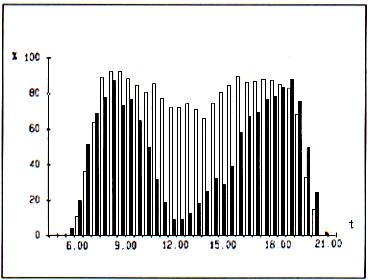
ritorno/back
Fig. 2: Percent of animals feeding during above ground activity in less frequented areas (white) and in the vicinity of paths (black)
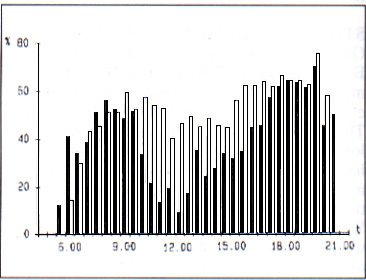
ritorno/back
Fig. 3: Distance of the marmots to the path in 20 meter-zones during different times of the day.
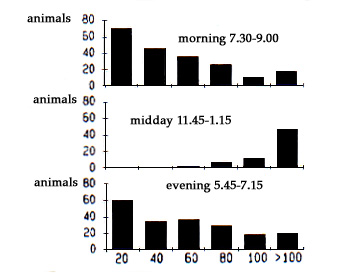
ritorno/back
Fig. 4: Flight distance in highly frequented areas (hf) and in less frequented areas (lf). Median, first and third quartil, minima and maxima (Mann-Whitney U-Test: p< 0.001)
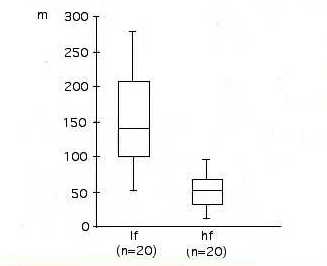
ritorno/back
Fig. 5: Interval until the first animal reappears in highly frequented (hf) and less frequented (lf) areas. N=10 each.
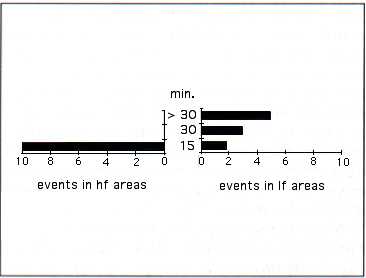
ritorno/back
Fig. 6: Flight distance of marmots when confronted with hikers on a trait (on T) compared with those crossing the territory at random (off T). Median, first and third quartil, minima and maxima (Mann- Whitney U-Test: p<0,01).
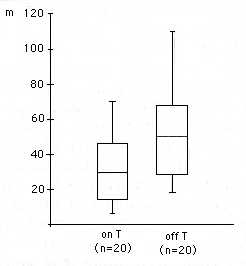
ritorno/back
Tornare index / back contents
Â
Â





